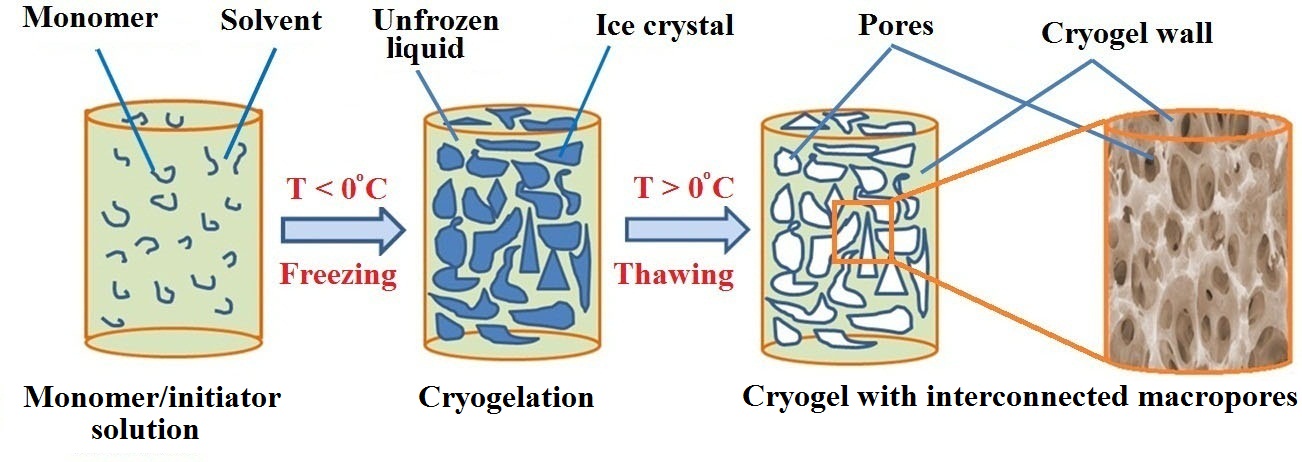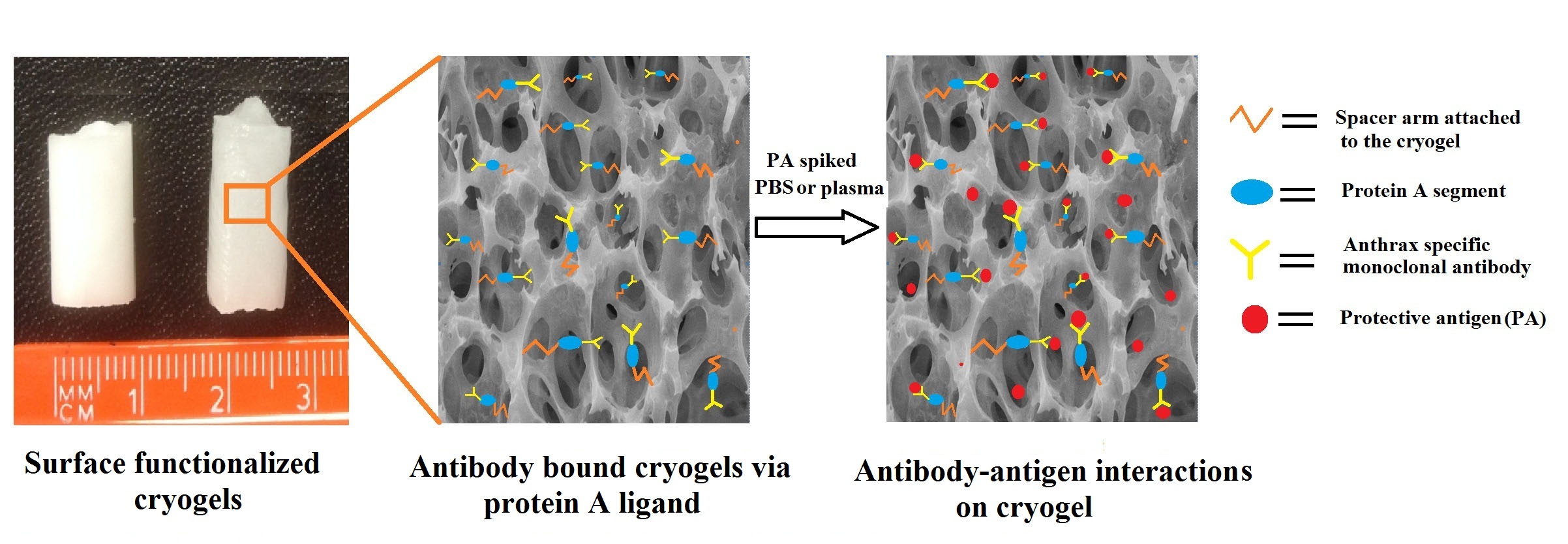Cryogels, characteristically sponge like macro-porous hydrogels formed at temperatures below the freezing point of the solvent (e.g. water) by cryogelation (Fig.1), have recently gained significant interest in biomedical and therapeutic applications due to their inherent interconnected macro-porous structure and ease of formation in comparison to other macro-pore forming techniques[1]-[6]. The aim of the study was to demonstrate the potential use of macroporous monolithic cryogels for removal of anthrax toxin protective antigen (PA), the central cell-binding component of the anthrax exotoxins, and covalent immobilization of monoclonal antibodies. The affinity ligand (protein A) was chemically coupled to the reactive hydroxyl and epoxy-derivatized monolithic cryogels and the binding efficiencies of protein A, monoclonal antibodies to the cryogel column were determined. Our results show differences in the binding capacity of protein A as well as monoclonal antibodies to the cryogel adsorbents caused by ligand concentrations, physical properties and morphology of surface matrices. The cytotoxicity potential of the cryogels was determined by an in vitro viability assay using V79 lung fibroblast as a model cell and the results reveal that the cryogels are non-cytotoxic. Finally, the adsorptive capacities of PA from phosphate buffered saline (PBS) and human plasma were evaluated towards a non-glycosylated, plant-derived human monoclonal antibody (PANG) and a glycosylated human monoclonal antibody (Valortim®), both of which were covalently attached via protein A immobilization (Fig.2). Optimal binding capacities of 108 and 117 mg/g of antibody to the adsorbent were observed for PANG attached poly(acrylamide-allyl glycidyl ether) [poly(AAm-AGE)] and Valortim® attached poly(AAm-AGE) cryogels, respectively, This indicated that glycosylation status of Valortim® antibody could significantly increase (8%) its binding capacity relative to the PANG antibody on poly(AAm-AGE)-protien-A column (p<0.05). The amounts of PA which remained in the solution after passing PA spiked PBS or human plasma through PANG or Valortim bound poly(AAm-AGE) cryogel were significantly (p < 0.05) decreased relative to the amount of PA remained in the solution after passing through unmodified as well as protein-A modified poly(AAm-AGE) cryogel columns, indicates efficient PA removal over 60 minutes of circulation. The high adsorption capacity towards anthrax toxin PA of the cryogel adsorbents indicated potential application of these materials for treatment of Bacillus anthracis infection.

Figure 1. Schematic illustration showing different stages involved during cryogel formation.

Figure 2. Antibody bound adsorbent columns and cartoon illustration showing antibody-antigen interactions within porous structure.
This work was funded by the People Programme (Marie Curie Actions) of the European Union's Seventh Framework Programme, Industry-Academia Partnerships and Pathways (IAPP) project ‘Adsorbent Carbons for the Removal of Biologically Active Toxins (ACROBAT-Grant agreement no. 286366 FP7-People-2011-IAPP)’; The authors would like to thank PharmAthene Inc, (Annapolis, Maryland, USA) and Fraunhofer USA Inc, (Newark, Delaware, USA) for the kind gift of antibodies Valortim® and PANG, respectively
References:
[1] Plieva F. M. et al., J. Sep. Sci. 30:1657-71. 2007
[2] Kumar A. et al., J. Mol. Recogn. 18:84-93, 2005
[3] Hwang Y. et al., Tissue Eng. Part A. 16:3033-41, 2010
[4] Bereli N. et al., J. Chrom. A. 1190:18-26, 2008
[5] Baydemir G. et al., Colloids Surf. B. 68:33-8, 2009
[6] Sun H. et al., J. Sep. Sci. 31:1201-6. 2008